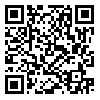Volume 6, Issue 4 (2020)
IEM 2020, 6(4): 277-283 |
Back to browse issues page
1- Department of Biology, Gorgan Branch, Islamic Azad University, Gorgan, Iran , lili_kia@yahoo.com
2- Department of Biology, Gorgan Branch, Islamic Azad University, Gorgan, Iran
2- Department of Biology, Gorgan Branch, Islamic Azad University, Gorgan, Iran
Abstract: (1345 Views)
Background: Brucellosis is an important zoonotic disease with significant economic and public health consequences. This study aimed to investigate the seroepidemiological prevalence of human brucellosis in Gorgan and Dasht, Northeastern Iran during one year.
Materials & Methods: In this study, 153 brucellosis-suspected cases who were referred to the health centers of Gorgan and surrounding villages from April 2017 to March 2018, were included. Two serological assays (Wright and 2-mercaptoethanol) were performed on all sera taken from patients. Data were analyzed by SPSS software (version 23) using Chi-square test and independent t-test. A p-value less than .05 was considered as statistically significant.
Findings: Of 153 suspected cases, 62 cases (40.5%) were positive for brucellosis, among whom 39 cases (62.9%) were men, and 41 cases (66%) were 17-38 years old. The highest prevalence rate of brucellosis was observed in rural men (69.5%) as well as in those consuming raw cheese (35.5%) and being in direct contact with livestock (27.5%). Furthermore, the frequency of the disease was significantly higher in the summer. The incidence rate of the disease was significantly associated with season, history of contact with livestock, and the type of dairy product consumed (p <.05).
Conclusion: The prevalence of brucellosis is higher in rural areas of Gorgan, particularly among farmers and livestock keepers. Providing training and raising awareness of these individuals as well as developing strategic health plans regarding the consumption of unpasteurized dairy products could help reduce the incidence of brucellosis.
Materials & Methods: In this study, 153 brucellosis-suspected cases who were referred to the health centers of Gorgan and surrounding villages from April 2017 to March 2018, were included. Two serological assays (Wright and 2-mercaptoethanol) were performed on all sera taken from patients. Data were analyzed by SPSS software (version 23) using Chi-square test and independent t-test. A p-value less than .05 was considered as statistically significant.
Findings: Of 153 suspected cases, 62 cases (40.5%) were positive for brucellosis, among whom 39 cases (62.9%) were men, and 41 cases (66%) were 17-38 years old. The highest prevalence rate of brucellosis was observed in rural men (69.5%) as well as in those consuming raw cheese (35.5%) and being in direct contact with livestock (27.5%). Furthermore, the frequency of the disease was significantly higher in the summer. The incidence rate of the disease was significantly associated with season, history of contact with livestock, and the type of dairy product consumed (p <.05).
Conclusion: The prevalence of brucellosis is higher in rural areas of Gorgan, particularly among farmers and livestock keepers. Providing training and raising awareness of these individuals as well as developing strategic health plans regarding the consumption of unpasteurized dairy products could help reduce the incidence of brucellosis.
Article Type: Original Research |
Subject:
Bacteriology
Received: 2020/08/12 | Accepted: 2020/12/1 | Published: 2020/11/20
Received: 2020/08/12 | Accepted: 2020/12/1 | Published: 2020/11/20
| Rights and permissions | |
 |
This work is licensed under a Creative Commons Attribution-NonCommercial 4.0 International License. |





